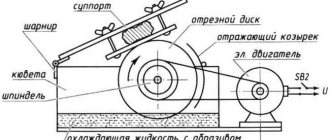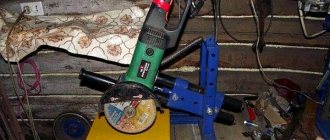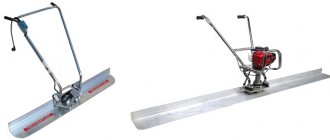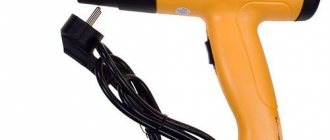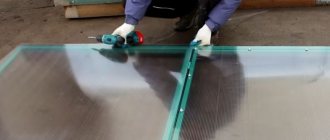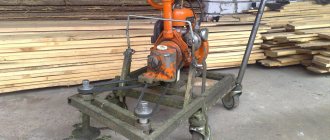Purpose
A do-it-yourself drill lathe can be used to process simple wooden and metal parts. An ordinary household electric drill is used as a drive.
Waves of doubt will be dispelled after studying the drawings of a lathe from a drill. It will not be difficult for a savvy home craftsman to select the necessary components in his home workshop.
Using a homemade lathe for its intended purpose, you can to some extent quench the thirst of your desires and make simple products. These can be handles for plumbing tools, elements of country furniture, all kinds of decorative crafts.
Selecting materials to create a device
Very often among home craftsmen there are those who try to make their own lathe from an electric drill.
The manufacturing process is not at all complicated, and to achieve the desired result you will need to take all the necessary materials to prepare them in advance. In the production of the machine, woodworking materials can be used, but you should be aware that with such devices you can only process small parts and workpieces, for example, make handles for knives, handles for furniture, etc. If you need a reliable sled that you plan to use very often, then it’s worth investing once and making it out of metal.
Lathe device
The design of a homemade lathe from a drill is based on components that are important for their intended purpose. We will analyze the function of each node in detail in the following sections of the article.
Base
The frame of the processing device accommodates all the components and ensures the stability of the structure.
The stationary design requires a more massive base, unlike tabletop lathes.
Headstock
This unit is involved in fixing the workpiece and transmitting torque from the drive to it. The part is firmly fixed in the spindle assembly chuck. The design may be movable in some homemade products.
The stationary design involves rigidly securing the base of the machine and the headstock.
Tailstock
This movable unit of turning equipment ensures reliable fastening of the part. The tailstock can move freely along the guide rails, providing the necessary pressure to the chuck and centering the part.
The mobility of this unit requires precise location relative to the fixed part of the base. Thanks to this unit, it is possible to process parts of various lengths.
Caliper
This knot is also called a handy knot. The cutting tool has a support as a stop, which moves along the longitudinal and transverse axis of the machine. The transverse movement of the caliper reduces the working arm of the cutter.
After installing the support platform in the working position, it is fixed with bolts in the right place. However, the cutter itself is held and pressed against the part by hand.
Woodworking Machine
The woodworking equipment market offers an extensive line of wood lathes. Each consumer makes his choice taking into account his interests, but the main criterion is the drive power. For a home workshop where turning work is performed sporadically, a simple tabletop machine with an electric motor power of 1 kilowatt and a spindle speed of 3500 rpm is suitable.
https://youtube.com/watch?v=xs8KOp1HoFI
The main components and mechanisms of a wood lathe correspond to the classic structure of a lathe, which processes workpieces by rotation. Three main mechanisms:
- drive - electric motor, single-phase or three-phase;
- transmission - a set of devices that transmit the rotation of the motor shaft to the spindle head;
- the executive is the support.
Four main nodes:
- bed - the body on which the mechanisms are fixed;
- front spindle headstock - for attaching a faceplate or lathe chuck;
- rear fixing headstock - for installing a rotating center or drill chuck.
Popular articles Chicken Coop
Design feature
You can assemble a wood lathe with your own hands from available materials. The design is simple and does not require much time to manufacture. The main part of the machine is a bed made of a channel, in which a groove is cut along the central center line with a grinder for fixing the tool rest and tailstock. The fixation principle is an eccentric mechanism.
The tailstock design is standard. The quill has a hole for Morse taper No. 2 to set the center of rotation. The drill chuck shank matches the quill hole. It is recommended to use a factory made tailstock.
Under the quill, machine a hollow cylinder with a blank end wall, in which a thread is cut for the flywheel screw. The moving part of the quill is a cylinder with a conical hole and a keyway along its entire length. The moving part moves with the help of a flywheel screw along a key welded in the headstock body.
The tool rest is classic, has an adjustment function with fixation to the diameter of the workpiece being processed, the base of the tool rest moves across and along the bed. It is fixed with an eccentric with a handle. The upper part is a regular corner.
The headstock has two angular contact bearings. The spindle shaft has an M14 thread, step two. This is a thread that is used on grinders and grinders. Thanks to this, all the attachments used by the grinder can be attached to the spindle.
DIY spindle head
The quality of the entire structure depends on the accuracy of the headstock manufacturing
Therefore, special attention must be paid to this node. Craftsmen recommend making the headstock of a lathe with your own hands
To do this, you need to machine a cylindrical body with a wall thickness of 10 mm. To attach it to the frame, you need to make a special stand. A section of channel is suitable for this. The channel end is welded to a corner made of sheet steel 10 mm thick. The headstock body is attached to the resulting stand.
To make a wood lathe with your own hands, drawings and dimensions do not matter, since everyone makes the design individually, taking into account their capabilities. Sectional view of a cylindrical body:
- outer diameter 56 millimeters;
- wall thickness 10 millimeters;
- length 180 millimeters;
- mounting sockets for bearings with a diameter of 24 millimeters;
- shaft with a diameter of 30 millimeters.
Simple accessories make the machine universal and increase the list of operations. For example, by installing a sanding drum with sandpaper in the chuck, you can sharpen the tool. The device for turning on a copy machine looks like this:
- copier;
- a pipe installed along the frame, acting as a slide;
- circular electric saw that acts as a wood cutter.
The milling attachment will replace the milling machine. Arbor with disc cutter
is clamped into the chuck. Instead of a tool rest, a work table with a stop ruler is installed. You can mill platbands, baseboards, and blanks for frames.
Enthusiasts and lovers of making homemade items are constantly coming up with mechanisms that make manual labor easier. Such people always have an answer to the question of how to make a woodworking machine.
Design features of a lathe for working with metal
If, according to the master’s plan, metal parts are supposed to be processed on a lathe, you need to approach the task thoroughly. You should take into account the design of the drill and the size of the parts that you plan to process.
The design of a homemade lathe must be stable and rigid. The guides must be made of steel square pipes. The base is framed with a steel angle to give rigidity.
It should be borne in mind that a metal lathe from a drill can only process extremely soft metal. These include aluminum, copper, bronze and their alloys.
Preparing for work
Tool
To make a wood lathe from a drill, you will need the following tool:
- Sawing machine or circular saw.
- Jigsaw.
- Grinder (if correct, then an angle grinder (angle grinder).
- Screwdriver or drill.
- Grinding machine.
- Hand tools: clamps, screwdriver, hammer, square, marking pencil, etc.
Material and components
To make a woodworking machine with your own hands, you will need the following materials and components:
- Plywood 15 mm.
- Pine massif;
- Wing nut;
- Fastening: M6 bolt, self-tapping screws of various lengths.
Main structural elements
The design of a homemade lathe based on a drill consists of the following parts:
- Base: Frame;
- Spindle box;
Basic recommendations
To summarize, it is worth noting that the possibilities of a homemade machine from a drill can delight the imagination of a home craftsman. The choice of lathe design should be approached responsibly. It is advisable to obtain the blessing of a specialized specialist.
You will get a fairly stable and reliable design of a homemade lathe if the guides are made of square steel pipes.
It should be recalled that only high-quality components will allow you to get pleasure from the work and, ultimately, the expected result.
The finished turning device, which is made by the caring hands of hardworking Chinese workers, has a starting price of 6,000 rubles.
Good results in your work.
Components of a home lathe
In terms of design, a home machine is not much different from stationary production equipment.
The common components of any machine equipment associated with wood turning include:
- The bed is a fixed support platform on which the entire structure is mounted. Factory stationary machines are equipped with a fixed metal support. In homemade mini-machines, you can use strong wooden beams connected to each other by timber as a frame. The bed is “responsible” for the stability of all turning equipment.
- A headstock placed on the support of a lathe. The main purpose of this unit is to accurately support and move the wood workpiece being processed in relation to the electric drill drill. Depending on the location on the machine equipment and the functional purpose, this unit is divided into a headstock, which is responsible for the accuracy of the rotational movement, and a tailstock, the main purpose of which is to create the thrust part of the machine.
- Electric motor for creating rotational torque of the workpiece. Factory stationary models are equipped with three-phase electric drives operating at a voltage of 380 W and an electric motor speed of 1500 rpm. In the home version, an electric motor with a power of 200 to 400 W is sufficient.
The tailstock and headstock are the main working parts of the lathe. A piece of wood is installed between the executive elements.
The lathe is equipped with: a lathe chuck, a rotation element, a special stop for placing the workpiece, a guide beam, fastening screws for fixing wooden blanks and other elements.
Machine turning equipment, regardless of the installation location (factory or home workshop), has the same operating principle:
- An electric motor transmits rotational motion to the workpiece through the headstock.
- The tailstock remains in a static position and holds the locked part motionless.
- The movement of the headstock is created by a manual drive.
Photos of lathes from a drill
What is a lathe, and it’s possible to make it yourself
Before making a device, you should first consider the factory lathe, as well as its design.
Factory devices are based on the following elements:
- Base (bed).
- Back and front headstock.
- Caliper (also called a support).
Next, we suggest taking a closer look at why such elements are required so that you have a complete understanding of what you will need to create a homemade lathe from a drill.
- The base is a device that connects the component parts of the device, and the frame is needed to ensure that the entire equipment is stable. If we are talking about a factory machine, then the base on it is fixed, monolithic, because the total weight of the device is very large.
is a part of the device that is needed for fastening and performing rotational movements inside the workpiece. Simply put, the headstock is a mount that stands perpendicular to the base, and on a factory machine, a drive mechanism should be attached to the front support, thanks to which the workpiece rotates. To do this, the clamp has a special design in order to center the workpiece and also sets it in motion.
Headstock (support) –- c
, which is responsible not only for free rotation and centering, but also for adjusting the length, depending on the size of the workpiece. The movable shaft of the rear support is centered with the drive shaft of the first support. - A support is also a tool that is required for processing a workpiece. It moves exactly along the bed, and this makes it possible to create uniform processing of a rotating part, which is fixed on the front and rear support. Thanks to the support, the turner can move a hand-type cutting tool in the form of a chisel throughout the workpiece.
If the gap between the stop for the cutters and the part being processed is large, then during the process the cutting tool (chisel) may be pulled out of your hands. To prevent this from happening, when constructing a lathe, you should take into account the mobility of the support in each direction. Knowing how a factory lathe for processing wood is made, you should act and begin manufacturing a similar device from an electric drill.
Types of machines
The lathe itself belongs to specialized equipment, which can be heavy and household. The former are characterized by a large size, which allow you to work with parts of significant dimensions. Such devices are needed more in professional activities and in the wood processing industry.
The second type of installation is characterized by the fulfillment of small household needs - cutting and processing legs for a stool, or partitions for railings. This does not require any special power of the device, nor does it require any size.
You may have seen a photo of a lathe made from a drill - there is a ready-made platform to which the drill is attached on one side, and the part is clamped on the other. You can buy such a stand in a store, because the use of a drill is not typical only for folk recipes.
Only the price tag for such a platform can reach tens of thousands of rubles, which in itself is not very justified. The average price tag on the market will be half the mentioned amount, which is still a bit much, taking into account the complexity of the design. That’s why creating such a machine with your own hands is not a bad idea at all.
Rules of care and use
Having made efforts to create homemade equipment, you will probably want it to serve in good condition for as long as possible and be pleased with the result of its work. To do this, you must follow a number of rules for care and operation:
- timely removal of waste that falls on the surface of the machine during operation;
- periodically tightening all connections, as they become loose during vibration;
- storing the lathe after work in a dry place, since if the machine has wooden parts, then they can swell over time due to moisture, and if they are metal, they can rust;
- replacement of all parts if they fail before starting new turning work.
Thus, this article clearly shows that any craftsman, even with minor assembly skills, can handle the task of independently assembling a wood lathe from a drill. At the same time, spending a minimum amount of financial, time resources and space in your garage or workshop to store this unit.
Also, this equipment is unpretentious in care and maintenance, which can rightfully be considered another advantage of a homemade lathe in addition to all those described above.

